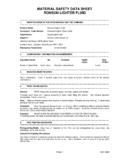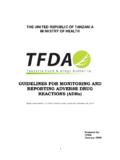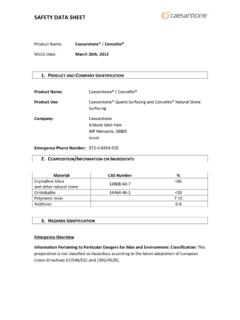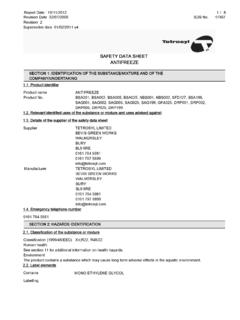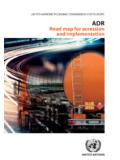Transcription of VACCINE SAFETY BASICS - World Health …
1 VACCINE . SAFET Y. BASICS . l e a r n i n g m a n u a l The content of this course has been compiled by leading international VACCINE experts who are committed to the promo- tion of best practice in the implementation of immunization programmes across the World . CONTRIBUTORS. Molly Mort (project coordinator and writer of a pilot course, which served as basis of this course). Adele Baleta (South Africa), Frank Destefano (US CDC), Jane G. Nsubuga (US CDC), Claudia Vellozzi (US CDC), Ushma Mehta (Medicines Control Council, South Africa), Robert Pless (Public Health Agency of Canada), Siti Asfijah Abdoellah (NADFC Indonesia), Prima Yosephine (EPI-MOH, Indonesia), Sherli Karolina (EPI-MOH, Indonesia).
2 PHOTO CREDITS. Barbara Pahud (Children's Mercy Hospitals and Clinics, UMKC), WHO Photo Library, CDC Photo Library. OVERALL COORDINATION (WHO). Patrick Zuber, Philipp Lambach. DESIGN AND TECHNICAL IMPLEMENTATION. Oksana Fillmann, Munich. SEND US FEEDBACK. Please let us know how you liked the course. Send us an email with your suggestions to: World Health Organization 2013. All rights reserved. Publications of the World Health Organization can be obtained from WHO Press, World Health Organization, 20 Avenue Appia, 1211 Geneva 27, Switzerland (tel: +41 22 791 3264; fax: +41 22 791 4857; email: Requests for permission to reproduce or translate WHO.)
3 Publications whether for sale or for noncommercial distribution should be addressed to WHO Press, at the above address (fax: +41 22 791. 4806; email: The designations employed and the presentation of the material in this publication do not imply the expression of any opinion whatsoever on the part of the World Health Organization concerning the legal status of any country, territory, city or area or of its authorities, or concerning the delimitation of its frontiers or boundaries. Dotted lines on maps represent approximate border lines for which there may not yet be full agreement. The mention of specific companies or of certain manufacturers' products does not imply that they are endorsed or recommended by the World Health Organization in preference to others of a similar nature that are not mentioned.)
4 Errors and omissions excepted, the names of proprietary products are distinguished by initial capital letters. All reasonable precautions have been taken by the World Health Organization to verify the information contained in this publication. However, the published material is being distributed without warranty of any kind, either expressed or implied. The responsibility for the interpreta- tion and use of the material lies with the reader. In no event shall the World Health Organization be liable for damages arising from its use. Table of Contents 7. Getting 8. MODULE 1: Introduction to VACCINE 9.
5 10. Importance of immunization 10. History of VACCINE 11. Expectations towards SAFETY of 13. How the immune system 14. How vaccines 16. VACCINE -preventable 17. Types of 18. Adverse 19. Frequency and VACCINE SAFETY in immunization VACCINE 25. Pre-licensure VACCINE Post licensure surveillance Balancing efficacy and 31. ASSESSMENT Assessment MODULE 2: Types of VACCINE and adverse 38. Types of Live attenuated Inactivated whole-cell Subunit Toxoid Combination 3. Components of a 51. Route of 55. Immunizing the 57. Immunization and Vaccination associations and public ASSESSMENT 61. Assessment 65.
6 MODULE 3: Adverse events following 67. Classification of 69. VACCINE Immunization error-related Immunization anxiety-related Coincidental Mass vaccination 78. Rates of adverse VACCINE 79. 82. ASSESSMENT Assessment MODULE 4: 89. 91. NRA's role in the regulation of drug 92. Adverse Drug Reaction (ADR) Immunization SAFETY requires a modified surveillance VACCINE 95. Special considerations for AEFI Interactions between AEFI and ADR surveillance 97. 4. AEFI surveillance Detection and Causality assessment of Risk/benefit 107. ASSESSMENT 108. Assessment MODULE 5: VACCINE SAFETY institutions and 113.
7 114. Overview of 115. NATIONAL LEVEL. National AEFI surveillance 116. National regulatory 117. Core functions specific to 117. Functions depending on the source of VACCINE procurement and lot 119. Regulation of drug National immunization programmes (NIP).. 121. Core functions specific to VACCINE SAFETY of VACCINE AEFI Review 123. Other support 123. INTERNATIONAL LEVEL. Global VACCINE SAFETY stakeholders and 125. Global analysis and 127. Global Advisory Committee on VACCINE SAFETY (GACVS)..127. Good information practices VACCINE SAFETY Global Capacity building and harmonized 130. Brighton Collaboration setting standards in VACCINE CIOMS/WHO working VACCINE SAFETY training 5.
8 Global signal evaluation and WHO Programme for International Drug Global VACCINE SAFETY DataNet (GVSD)..134. Product 136. Global VACCINE SAFETY 137. 138. ASSESSMENT 139. Assessment MODULE 6: 145. Risk 147. Need for improved Communicate only reliable Simplified and key Risk Sources of Communicating in Responding to VACCINE SAFETY 156. Rumours and Impact of rumours and Responding to rumours and Communicating with the 162. Preparing a press Preparing for an 166. ASSESSMENT 167. Assessment 171. 174. 197. Questions 6. INTRODUCTION. Goal This course aims to establish a shared understanding among professionals whose work is linked to vac- cine SAFETY issues.
9 This may include nurses/midwives/community Health workers, as well as pharmacists medical doctors and programme or technical officers. The course covers Vaccines Communication characteristics of: Adverse events VACCINE SAFETY following stakeholders immunization Pharmacovigilance Rationale Professionals involved in VACCINE SAFETY come from different backgrounds. As their jobs are all interrelated and co-dependent, they need a common language' in order to ensure smooth collaboration. This Learning manual on VACCINE SAFETY BASICS is based on the E-learning Course on VACCINE SAFETY BASICS , which is available at It has been designed to reach out to users that do not have internet access.
10 In case you have internet access, we encourage the online use of the E-learning Course on VACCINE SAFETY BASICS , which enables the learner to benefit from interactive case studies and online assessments. The Learning manual on VACCINE SAFETY BASICS meets different starting points, learning needs and coun- try contexts. It offers the learner options to work at the speed and depth he prefers, recognizing his prior knowledge. Accommodating the different mechanisms between regions and nations is a challenge to any global course. For this reason we ask you from time to time to shift your focus to your own local context and look how VACCINE SAFETY is ensured in your country.











